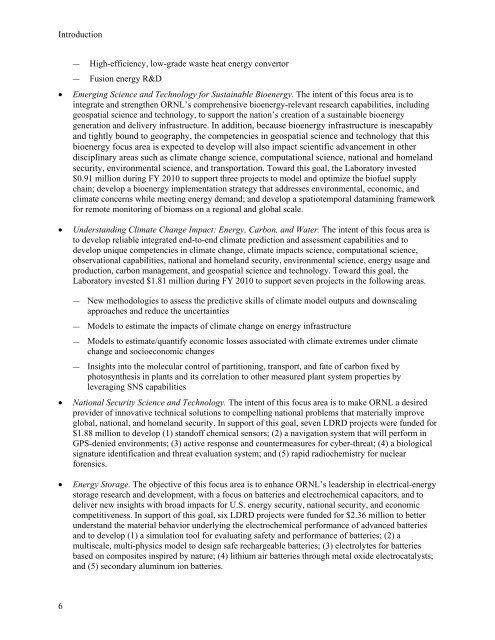FY2010 - Oak Ridge National Laboratory
FY2010 - Oak Ridge National Laboratory
FY2010 - Oak Ridge National Laboratory
You also want an ePaper? Increase the reach of your titles
YUMPU automatically turns print PDFs into web optimized ePapers that Google loves.
Introduction<br />
<br />
<br />
<br />
<br />
―<br />
―<br />
High-efficiency, low-grade waste heat energy convertor<br />
Fusion energy R&D<br />
Emerging Science and Technology for Sustainable Bioenergy. The intent of this focus area is to<br />
integrate and strengthen ORNL’s comprehensive bioenergy-relevant research capabilities, including<br />
geospatial science and technology, to support the nation’s creation of a sustainable bioenergy<br />
generation and delivery infrastructure. In addition, because bioenergy infrastructure is inescapably<br />
and tightly bound to geography, the competencies in geospatial science and technology that this<br />
bioenergy focus area is expected to develop will also impact scientific advancement in other<br />
disciplinary areas such as climate change science, computational science, national and homeland<br />
security, environmental science, and transportation. Toward this goal, the <strong>Laboratory</strong> invested<br />
$0.91 million during FY 2010 to support three projects to model and optimize the biofuel supply<br />
chain; develop a bioenergy implementation strategy that addresses environmental, economic, and<br />
climate concerns while meeting energy demand; and develop a spatiotemporal datamining framework<br />
for remote monitoring of biomass on a regional and global scale.<br />
Understanding Climate Change Impact: Energy, Carbon, and Water. The intent of this focus area is<br />
to develop reliable integrated end-to-end climate prediction and assessment capabilities and to<br />
develop unique competencies in climate change, climate impacts science, computational science,<br />
observational capabilities, national and homeland security, environmental science, energy usage and<br />
production, carbon management, and geospatial science and technology. Toward this goal, the<br />
<strong>Laboratory</strong> invested $1.81 million during FY 2010 to support seven projects in the following areas.<br />
― New methodologies to assess the predictive skills of climate model outputs and downscaling<br />
approaches and reduce the uncertainties<br />
― Models to estimate the impacts of climate change on energy infrastructure<br />
― Models to estimate/quantify economic losses associated with climate extremes under climate<br />
change and socioeconomic changes<br />
― Insights into the molecular control of partitioning, transport, and fate of carbon fixed by<br />
photosynthesis in plants and its correlation to other measured plant system properties by<br />
leveraging SNS capabilities<br />
<strong>National</strong> Security Science and Technology. The intent of this focus area is to make ORNL a desired<br />
provider of innovative technical solutions to compelling national problems that materially improve<br />
global, national, and homeland security. In support of this goal, seven LDRD projects were funded for<br />
$1.88 million to develop (1) standoff chemical sensors; (2) a navigation system that will perform in<br />
GPS-denied environments; (3) active response and countermeasures for cyber-threat; (4) a biological<br />
signature identification and threat evaluation system; and (5) rapid radiochemistry for nuclear<br />
forensics.<br />
Energy Storage. The objective of this focus area is to enhance ORNL’s leadership in electrical-energy<br />
storage research and development, with a focus on batteries and electrochemical capacitors, and to<br />
deliver new insights with broad impacts for U.S. energy security, national security, and economic<br />
competitiveness. In support of this goal, six LDRD projects were funded for $2.36 million to better<br />
understand the material behavior underlying the electrochemical performance of advanced batteries<br />
and to develop (1) a simulation tool for evaluating safety and performance of batteries; (2) a<br />
multiscale, multi-physics model to design safe rechargeable batteries; (3) electrolytes for batteries<br />
based on composites inspired by nature; (4) lithium air batteries through metal oxide electrocatalysts;<br />
and (5) secondary aluminum ion batteries.<br />
6
















